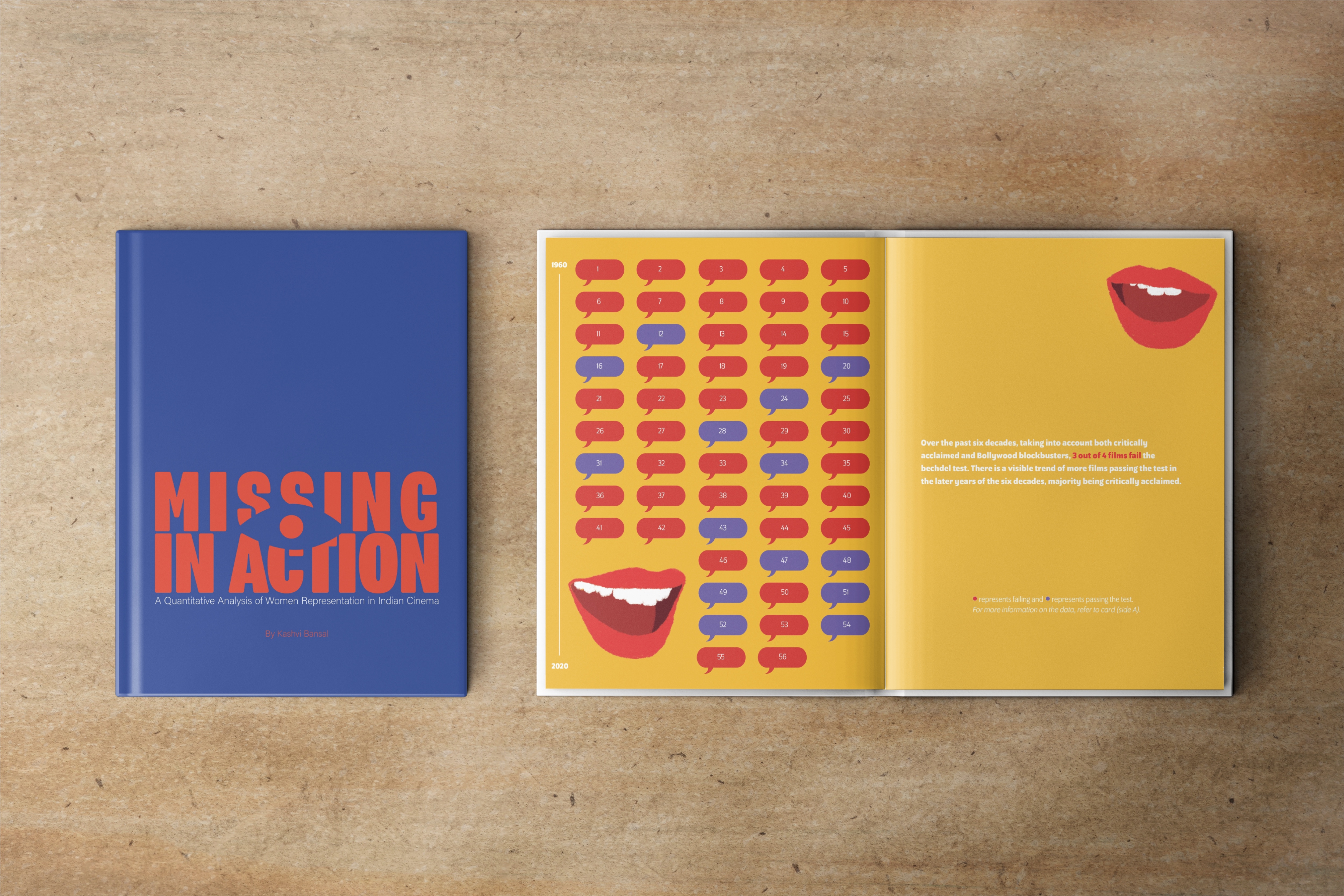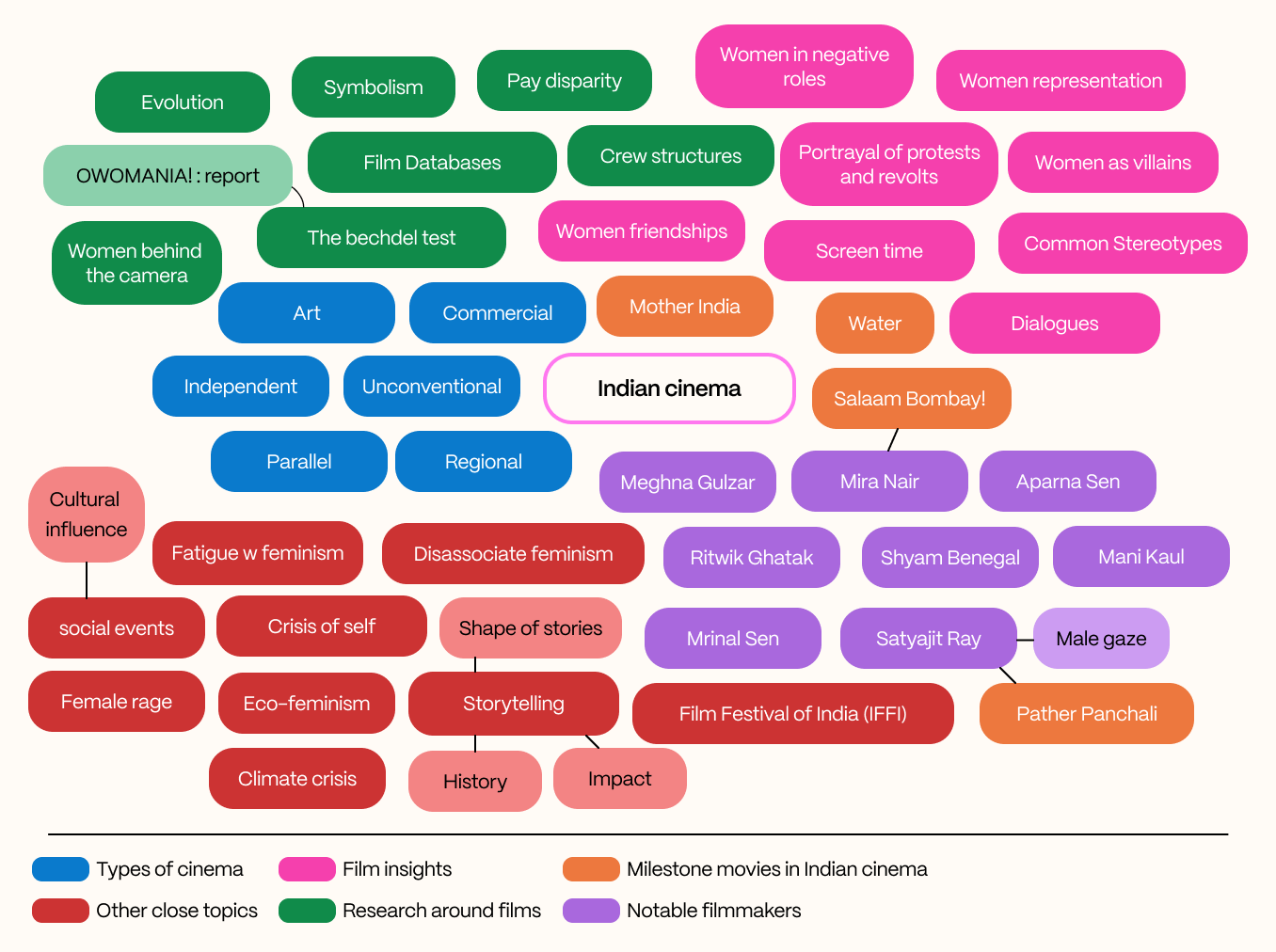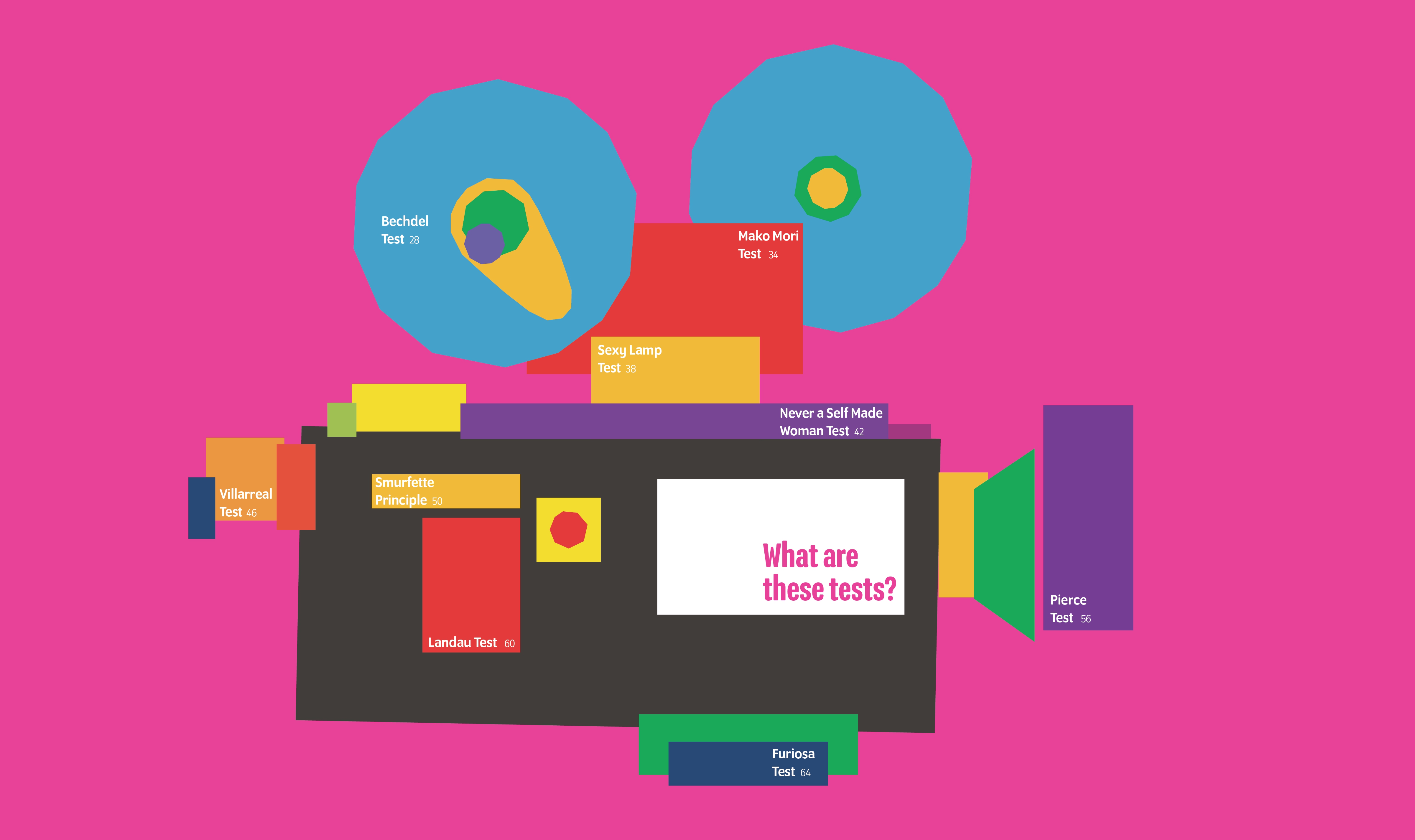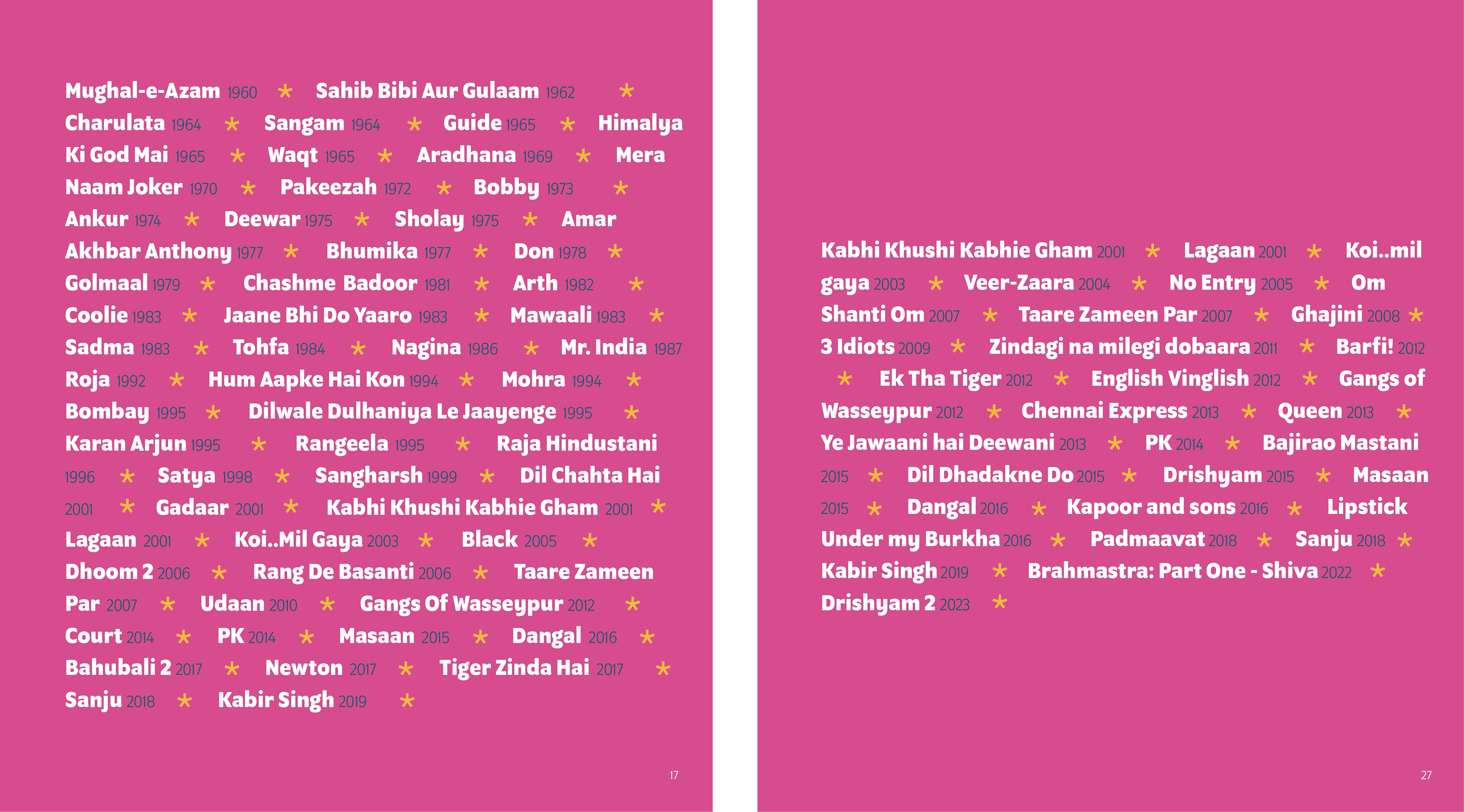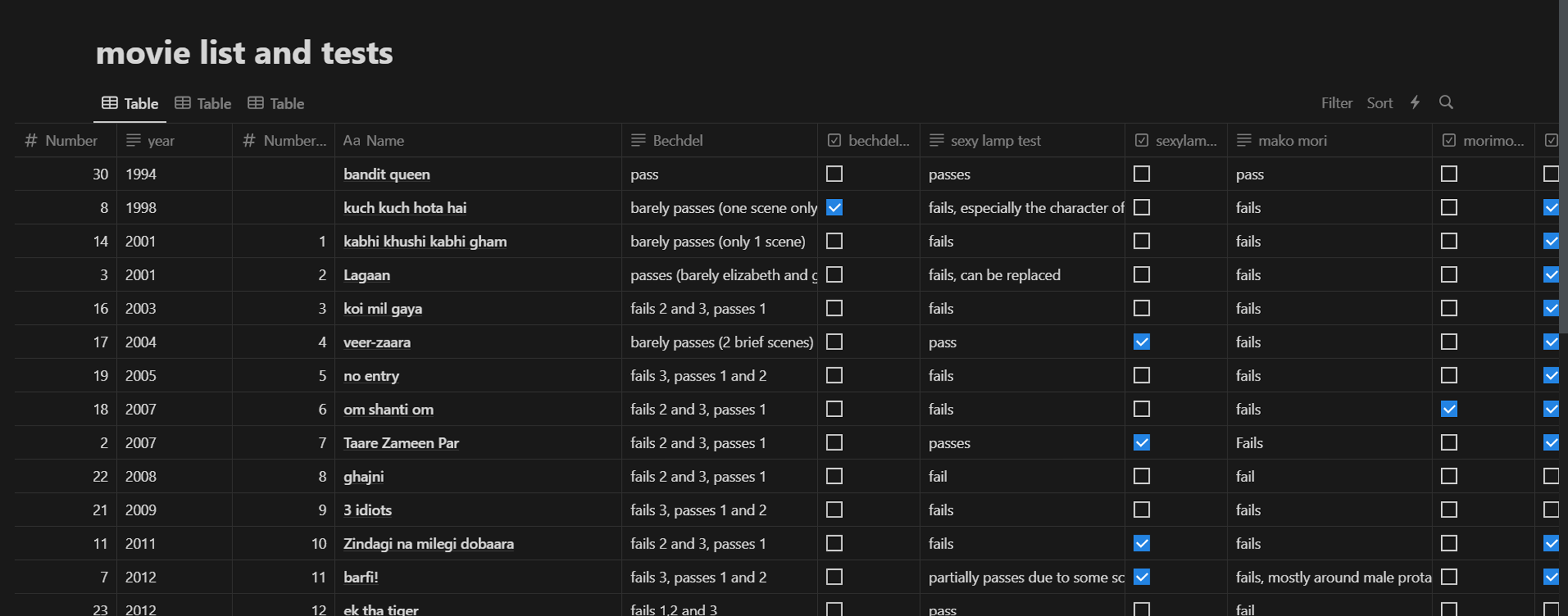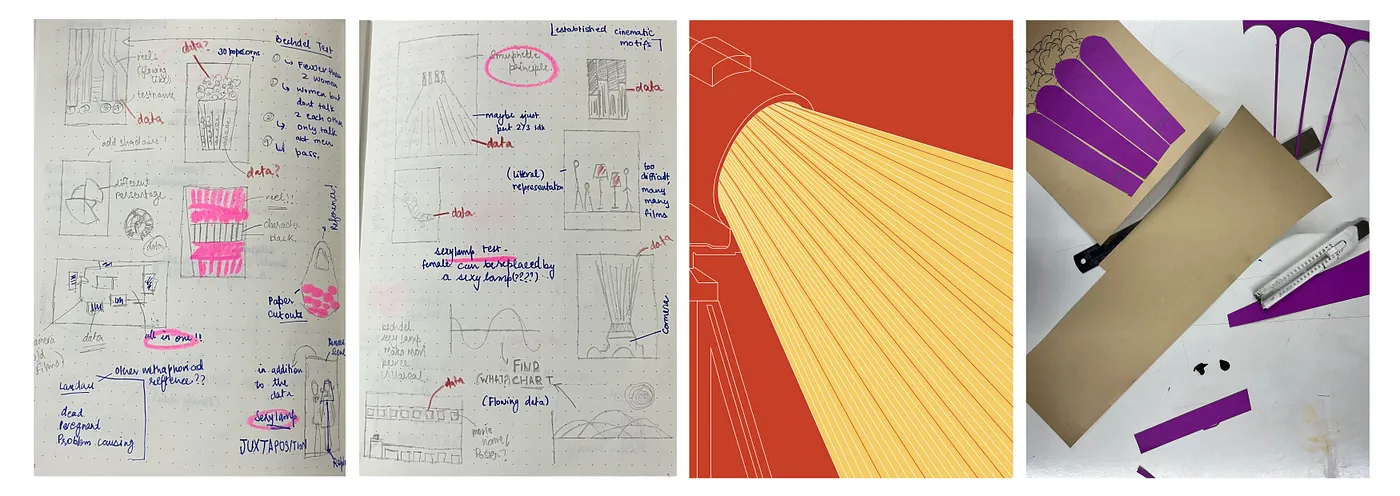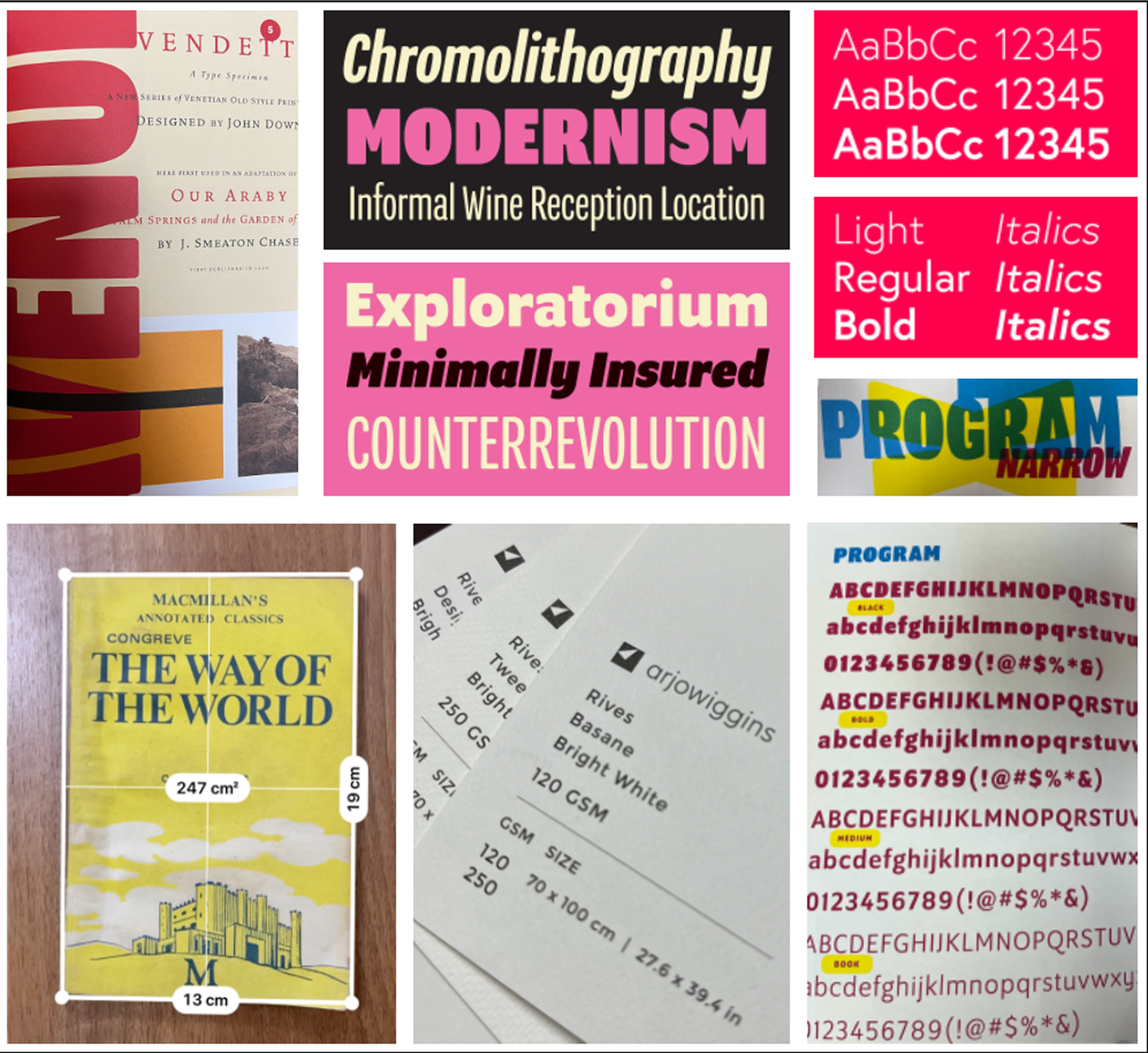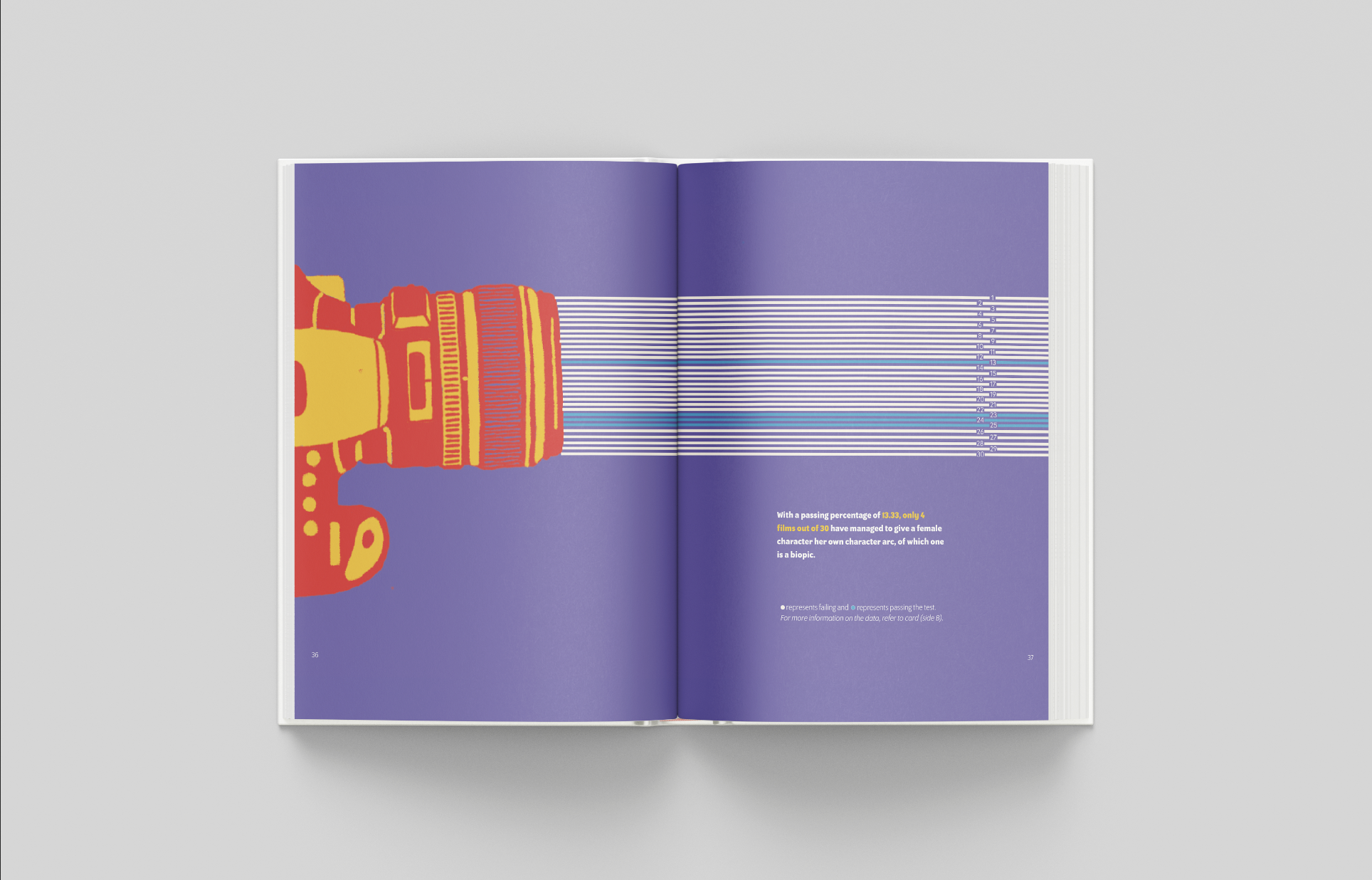RESEARCH, DATA VISUALISATION AND PUBLICATION DESIGN, FEB - MAY 2023
at
the INDIAN INSTITUTE OF ART AND DESIGN
As part of my graduation course, I took on a self-driven,
four-month-long project that looked closely at gender disparity in
Indian cinema. I used design research and storytelling to understand
and unpack the many ways in which women’s presence and contributions
in the industry are limited—often by deep-rooted systems and
biases.
At the heart of this project was my belief that
art and media can play a powerful role in bringing transformative
social change. My aim through this project is to ignite
conversations and inspire change in order for women in Indian cinema
to thrive without being held back by stereotypes, prejudice, or
outdated norms.
I began by trying to understand the larger landscape of Indian
cinema through its history, milestones, and the many forms it has
taken over time. I explored the rise of commercial cinema alongside
parallel, independent, main-stream and art films, curious about what
each reflected about the world around them.
As I mapped
this space, I grew interested in how cinema chooses to show
ambition, rage, and protest, and how films respond to and influence
cultural and political moments. This led me to explore related
themes like ecofeminism, climate change, and the role of
storytelling in shaping collective memory.
Along the way,
I studied landmark films and influential filmmakers whose work
shaped the industry, and came across frameworks like the Bechdel
Test and the male gaze that helped me look more critically at how
women are represented on screen.
My research then shifted toward understanding women’s presence in
the industry, not just as characters, but as professionals behind
the scenes. I looked more deeply into pay gaps, crew structures,
screen time, portrayals of female friendships, and recurring
stereotypes. I came across a few reports and essays, including OWOMANIA by Ping-Pong Studio, that helped deepen my understanding.
It
became clear that these issues weren’t isolated. What stood out was
the lack of in-depth research that connects these issues to their
root causes. This gap became central to my project.
The project began with the question of how much women are seen in Indian cinema, but quickly shifted to how they’re seen. I looked beyond screen time into subtler
details—like character depth, agency, and role significance.
Starting
with the Bechdel Test, I explored several other frameworks that
assess female representation in film. Tests like the Pierce Test (do
women have their own desires?), the Sexy Lamp Test (can a woman be
replaced by a prop?), and the Villareal Test (do characters rely on
stereotypes?) helped me build a lens for analysis. I eventually
shortlisted nine that felt most relevant to this project.
For film selection, I focused on mainstream Hindi cinema—films that
are either box office hits or critically acclaimed. I wanted to
study the ones people already know and celebrate, to examine how
these influential stories write their female characters. The
timeline spans six decades, with deeper analysis on films made in
the 21st century to understand where we stand today.
For this project, I chose data visualisation as the primary medium
to explore and express what I was discovering. To make the data more
engaging, I decided to embed it into visual illustrations that act
as metaphors, rather than simple charts. Each visual draws from the
different tests and frameworks I explored, helping highlight how
women show up in cinema—both on-screen and off. This includes things
like character presence, narrative significance, screen time, and
crew structures behind the scenes.
The final outcome is a
print publication that brings everything together. I didn’t want to
tell just one story, but instead map a system, one that’s filled
with smaller patterns and details. The book begins with a card
listing all the films studied, printed on both sides. This card acts
as a reference the reader can return to as they flip through the
pages. It adds a small element of interaction that felt more
intuitive in print than on screen.
The tone throughout the work
is investigative but empathetic. The idea is to pause, observe, and
maybe start seeing things a little differently.
To begin the process of data collection, I shortlisted around 60
films spanning six decades, roughly about ten from each. This helped
build a broad contextual framework to understand how the
representation of women has shifted over time. I focused on things
we often overlook, like the presence of women as writers, directors,
or protagonists.
While this historical scan helped set
the stage, the core of my study focused on films released after
2000, studying them through the lens of nine various tests. Most of
the data collection was primary. I watched the films myself, guided
by a set of parameters based on the tests and tropes I had studied.
With each viewing, I tracked details scene-by-scene and organised
the information into a structured table, using a software notion.
One
film, Queen, became a deeper case
study. I watched it over seven times, referencing the screenplay
alongside. I looked closely at elements like screen time, dialogue,
themes, and songs to build a more nuanced picture of how female-led
narratives are written and brought to life in Indian cinema.
In order to get the visualisation process started, I first mapped
out the flow of the book. This helped me understand how the visuals
would sit across the pages, not just in terms of space, but also
tone, pacing, and what each one communicates. Thinking about the
flow of the narrative early on helped ensure that each visual played
a part in a larger system, rather than working in isolation.
Once
I had the data in place, I began analysing it to understand patterns
and insights. I started sketching ideas for visuals that could
integrate the data meaningfully. The core concept of each test
guided the form and structure of its visual. For instance, the
Bechdel Test focused on female dialogue, the Landau Test on revenge
arcs, and the Furiosa Test on online boycotts, all of which pushed
me to think differently about what should be shown and how.
These
explorations became the basis for charts, diagrams, and
illustrations. I leaned into visual metaphors to bring these
patterns to life. For example, I used a spotlight to talk about
narrative centrality and a silhouette of a heel to depict
stereotyping. These metaphors helped the visuals carry meaning, even
before the data was fully read.
In order to get the visualisation process started, I first mapped
out the flow of the book. This helped me understand how the visuals
would sit across the pages, not just in terms of space, but also
tone, pacing, and what each one communicates. Thinking about the
flow of the narrative early on helped ensure that each visual played
a part in a larger system, rather than working in isolation.
Once
I had the data in place, I began analysing it to understand patterns
and insights. I started sketching ideas for visuals that could
integrate the data meaningfully. The core concept of each test
guided the form and structure of its visual. For instance, the
Bechdel Test focused on female dialogue, the Landau Test on revenge
arcs, and the Furiosa Test on online boycotts, all of which pushed
me to think differently about what should be shown and how.
These
explorations became the basis for charts, diagrams, and
illustrations. I leaned into visual metaphors to bring these
patterns to life. For example, I used a spotlight to talk about
narrative centrality and a silhouette of a heel to depict
stereotyping. These metaphors helped the visuals carry meaning, even
before the data was fully read.
The final outcome was a printed book, accompanied by a reference
card placed at the front. Printed on both sides, the card lists all
the films studied and serves as a quick guide for the visuals that
follow. The book begins with an introduction to Indian cinema and a
broad look at how the portrayal of women has shifted (if at all)
across the past six decades. It then zooms into films from this
century, using data and visual metaphors to unpack the current
landscape. Toward the end, a detailed case study of the film Queen sits alongside a few examples where representation has been more
intentional and thoughtful.
The book doesn’t aim to tell
a singular story but to reflect the patterns that shape how women
appear in our films. It acts as a mirror, quietly asking the
industry and its audience to reconsider what they’ve long accepted.
While the tone remains empathetic, it encourages reflection and
responsibility. It closes with a call to do better, not just for the
sake of storytelling, but for a more inclusive future for Indian
cinema.
The project found its first audience at my graduation show, where
over 150 people engaged with the work in-person. Since then, its
reach has steadily grown. I was invited to present it at DesignUp 2024, where I shared my work with an audience of over a thousand people
from around the world. I’ve also spoken about the work multiple
times at the Indian Institute of Art and Design, and more recently
at smaller, more intimate spaces like Small Town Folk.
The conversations sparked by these sessions have been
some of the most rewarding parts of the journey. The impact is
ongoing in ways I couldn't have predicted when I first
started.
This project took shape with the constant support of my mentor Aarti
Uberoi. I’m thankful to Gagan Nahre, Ikroop Sadhu, and my batchmates
for their feedback and ideas along the way. A special thanks to
Pragyan James Ali for his significant help with data collection and
his involvement across different parts of the project.

